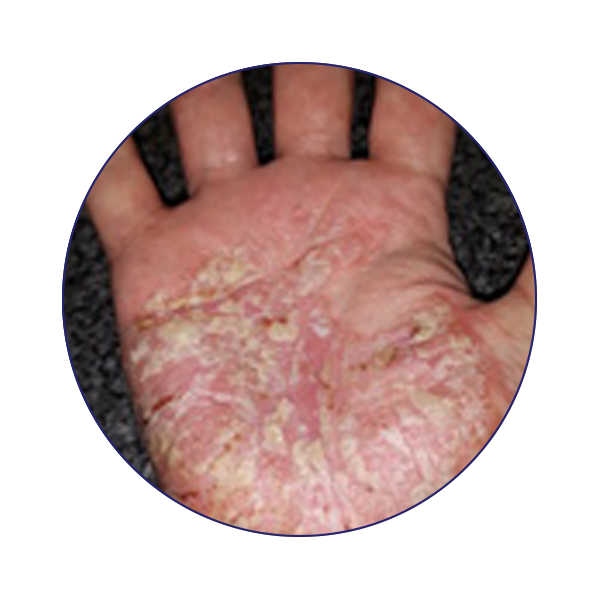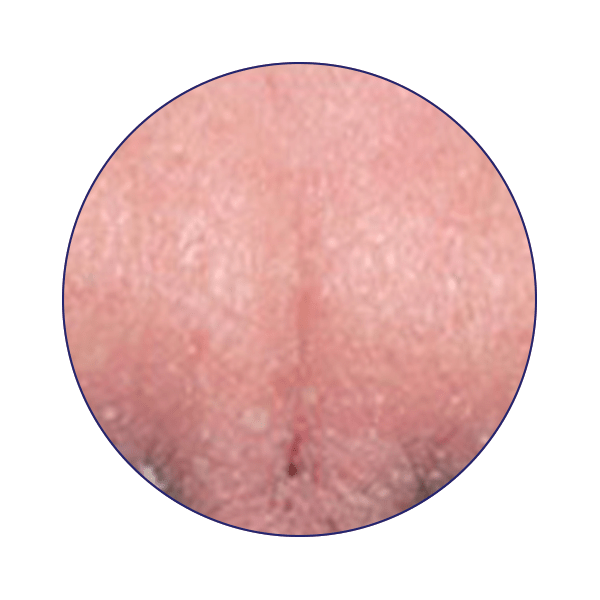

Atopic eczema (atopic dermatitis) is a chronic, relapsing itchy skin condition.1
People with atopic eczema have a reduction in the lipid barrier of the skin; this leads to an increase in water loss and a tendency towards dry skin.2
As water is lost from the stratum corneum, the corneocytes shrink, and cracks in the skin appear. These cracks allow irritants and allergens to penetrate the upper skin layers, leading to inflammation and pruritus. As patients scratch the skin, further damage is caused, resulting in the itch-scratch-itch cycle.3
![Asteotitic_Eczema_Web_WhatisEczema[2]](https://assethub.alliancepharmaceuticals.com/m/d48733f997eca6b/webimage-Asteotitic_Eczema_Web_WhatisEczema-2.png)
Asteatotic eczema, also known as eczema craquelé, is more common in the older population, however not unknown in younger patients.4
It is thought that this type of eczema is also the result of water loss from the stratum corneum, which is common in aging skin as it loses moisture and is typically drier.
Asteatotic eczema is characterised by dry, rough and scaly skin that resembles ‘crazy paving’.
Normally, this type of eczema is found on the lower legs and the incidence is at it’s highest during winter.4
![Pompholyx_Eczema_Web_WhatisEczema[82]](https://assethub.alliancepharmaceuticals.com/m/19161144df04304c/webimage-Pompholyx_Eczema_Web_WhatisEczema-82.png)
Pompholyx eczema, also known as dyshidrotic dermatitis, is a form of eczema that typically affects the palms of the hands and soles of the feet.5 Other names for this type of eczema are cheiropompholyx if it affects only the hands, or pedopompholyx if it affects only the feet.6
This type of eczema is characterised by tiny blisters under the skin which are extremely itchy.5
It is not known what causes this type of eczema, however Pompholyx eczema may be exasperated by emotional stress, or items that are an irritant to the skin such as detergents or certain chemicals such as perfumes.6
![Discoid_Eczema_Web_WhatisEczema[66]](https://assethub.alliancepharmaceuticals.com/m/4e393ee9eaed3ebe/webimage-Discoid_Eczema_Web_WhatisEczema-66.png)
Discoid eczema is also known as nummular eczema. As the name suggests, this type of eczema tends to have oval (disc like), very dry, itchy or cracked lesions. It can occur in any age but is most frequently seen in adults and is slightly more common in men than women.7
The lesions are normally found on the body and limbs. The face and scalp are usually spared. 8
As with most types of eczema, the cause of discoid eczema is unknown, however can be made worse when certain chemicals or materials come into contact with the skin.8
![webimage-613F0564-7B11-49CA-BD1DB2561A9809E2[26]](https://assethub.alliancepharmaceuticals.com/m/655e23a7aebd1d6e/webimage-webimage-613F0564-7B11-49CA-BD1DB2561A9809E2-26.png)
Varicose eczema, also known as gravitational eczema or statis is very common in people with varicose veins.
It is found on the lower legs and most often affects elderly patients. Symptoms include itchy, swollen, crusty, dry skin. The legs look very sore and inflamed.9
Patients are commonly given antibiotics as it is often confused with cellulitis (a bacterial infection of the inner layers of skin).10
In varicose eczema, the patient is generally well with sore, red legs but in cellulitis, they have a high temperature and feel shivery and unwell.10

Allergic dermatitis is triggered by an allergic response caused by contact with a substance(s).11
Irritant contact eczema (known as contact dermatitis) is caused by something irritating the skin, which is harder to identify. Both types can be very itchy and sore.11
If the dermatitis is caused by an allergy, the allergen may be detected via patch testing performed at the local dermatology department. Small amounts of potential allergens are placed on the skin and left on for 48 – 96 hours to see what reactions have occurred.11

Seborrhoeic dermatitis can be a frustrating type of eczema that commonly effects the face and scalp, where there is a lot of oil-producing glands.12
It is thought that seborrhoeic dermatitis is an inflammatory reaction related to an overgrowth of yeast on the skin surface. However, can be associated with the use of neuroleptic medications, emotional stress, immunosuppression and a family history of psoriasis.12
Seborrhoeic dermatitis is characterised by pale red patches with greasy, yellow coloured scales on the surface.12

Atopic eczema (atopic dermatitis) is a chronic, relapsing itchy skin condition.1
People with atopic eczema have a reduction in the lipid barrier of the skin; this leads to an increase in water loss and a tendency towards dry skin.2
As water is lost from the stratum corneum, the corneocytes shrink, and cracks in the skin appear. These cracks allow irritants and allergens to penetrate the upper skin layers, leading to inflammation and pruritus. As patients scratch the skin, further damage is caused, resulting in the itch-scratch-itch cycle.3
![Asteotitic_Eczema_Web_WhatisEczema[2]](https://assethub.alliancepharmaceuticals.com/m/d48733f997eca6b/webimage-Asteotitic_Eczema_Web_WhatisEczema-2.png)
Asteatotic eczema, also known as eczema craquelé, is more common in the older population, however not unknown in younger patients.4
It is thought that this type of eczema is also the result of water loss from the stratum corneum, which is common in aging skin as it loses moisture and is typically drier.
Asteatotic eczema is characterised by dry, rough and scaly skin that resembles ‘crazy paving’.
Normally, this type of eczema is found on the lower legs and the incidence is at it’s highest during winter.4
![Pompholyx_Eczema_Web_WhatisEczema[82]](https://assethub.alliancepharmaceuticals.com/m/19161144df04304c/webimage-Pompholyx_Eczema_Web_WhatisEczema-82.png)
Pompholyx eczema, also known as dyshidrotic dermatitis, is a form of eczema that typically affects the palms of the hands and soles of the feet.5 Other names for this type of eczema are cheiropompholyx if it affects only the hands, or pedopompholyx if it affects only the feet.6
This type of eczema is characterised by tiny blisters under the skin which are extremely itchy.5
It is not known what causes this type of eczema, however Pompholyx eczema may be exasperated by emotional stress, or items that are an irritant to the skin such as detergents or certain chemicals such as perfumes.6
![Discoid_Eczema_Web_WhatisEczema[66]](https://assethub.alliancepharmaceuticals.com/m/4e393ee9eaed3ebe/webimage-Discoid_Eczema_Web_WhatisEczema-66.png)
Discoid eczema is also known as nummular eczema. As the name suggests, this type of eczema tends to have oval (disc like), very dry, itchy or cracked lesions. It can occur in any age but is most frequently seen in adults and is slightly more common in men than women.7
The lesions are normally found on the body and limbs. The face and scalp are usually spared. 8
As with most types of eczema, the cause of discoid eczema is unknown, however can be made worse when certain chemicals or materials come into contact with the skin.8
![webimage-613F0564-7B11-49CA-BD1DB2561A9809E2[26]](https://assethub.alliancepharmaceuticals.com/m/655e23a7aebd1d6e/webimage-webimage-613F0564-7B11-49CA-BD1DB2561A9809E2-26.png)
Varicose eczema, also known as gravitational eczema or statis is very common in people with varicose veins.
It is found on the lower legs and most often affects elderly patients. Symptoms include itchy, swollen, crusty, dry skin. The legs look very sore and inflamed.9
Patients are commonly given antibiotics as it is often confused with cellulitis (a bacterial infection of the inner layers of skin).10
In varicose eczema, the patient is generally well with sore, red legs but in cellulitis, they have a high temperature and feel shivery and unwell.10

Allergic dermatitis is triggered by an allergic response caused by contact with a substance(s).
Irritant contact eczema (known as contact dermatitis) is caused by something irritating the skin, which is harder to identify. Both types can be very itchy and sore.
If the dermatitis is caused by an allergy, the allergen may be detected via patch testing performed at the local dermatology department. Small amounts of potential allergens are placed on the skin and left on for 48 – 96 hours to see what reactions have occurred.

Seborrhoeic dermatitis can be a frustrating type of eczema that commonly effects the face and scalp, where there is a lot of oil-producing glands.
It is thought that seborrhoeic dermatitis is an inflammatory reaction related to an overgrowth of yeast on the skin surface.
Seborrhoeic dermatitis is characterised by pale red patches with greasy, yellow coloured scales on the surface.
Did you know?
There is an increased prevalence of eczema in children where a parent is affected with 80% of children presenting with eczema where both parents are affected,26-28 and 60% in those where only one parent is affected.29
Other Dry Skin Conditions
Ichthyosis
Sometimes referred to as fish scale disease, ichthyosis is a condition that leads to dry, itchy skin that appears scaly and rough. Symptoms can vary from mild to severe.30
The condition is most commonly inherited from their parents through a mutated gene, however, acquired ichthyosis, which is not inherited, develops later in life and can be with other diseases such as lymphoma, diabetes, or HIV/AIDS.30
Psoriasis
Psoriasis is an immune conditions which causes the skin to inflame leading to thick, scaly areas of skin. The cause of psoriasis is an over-reactive immune system and can be triggered by emotional stress, infections, skin injury, or medications.31

Hydromol Range
NEXT SECTION
Diagnosis
Find out more about how to diagnose eczema.
NEXT SECTION
Treatment Options
Find out more about the different treatment options for eczema.
NEXT SECTION
Burden Of Itch
Chronic itch, defined as an itch lasting for longer than 6 weeks, is a highly
prevalent symptom of dry skin conditions along with the skin becoming dry,
cracked and irritated.
NEXT SECTION
Clinical Presentation
Find out more about the clinical presentation of eczema.
NEXT SECTION
Woundcare
Find out more about the role emollients play in caring for vulnerable skin.
NEXT SECTION
Follow-up and Referral
Find out more about when to follow-up and when to refer patients.
NEXT SECTION
Hydromol Range
Discover the Hydromol Range.
NEXT SECTION
Complete Emollient Therapy
Find out more about Complete Emollient Therapy
NEXT SECTION
Literature Reviews
Browse Dermatology literature reviews from 2019.
NEXT SECTION
Diagnosis
Find out more about how to diagnose eczema.
NEXT SECTION
Treatment Options
Find out more about the different treatment options for eczema.
NEXT SECTION
Burden Of Itch
Chronic itch, defined as an itch lasting for longer than 6 weeks, is a highly
prevalent symptom of dry skin conditions along with the skin becoming dry,
cracked and irritated.
NEXT SECTION
Clinical Presentation
Find out more about the clinical presentation of eczema.
NEXT SECTION
Woundcare
Find out more about the role emollients play in caring for vulnerable skin.
NEXT SECTION
Follow-up and Referral
Find out more about when to follow-up and when to refer patients.
NEXT SECTION
Hydromol Range
Discover the Hydromol Range.
NEXT SECTION
Complete Emollient Therapy
Find out more about Complete Emollient Therapy
NEXT SECTION
Literature Reviews
Browse Dermatology literature reviews from 2019.
2. Clinical Knowledge Summaries, Eczema – atopic. http://cks.nice.org.uk/eczema-atopic#!diagnosissub. Last accessed April 2023.
3. Cork MJ. Skin barrier breakdown: a renaissance in emollient therapy. BJN 2009;18(14):872-877.
4. Bolognia J et al; Eczema craquelé, Dermatology, 2012.
5. NHS Conditions: Pompholyx. https://www.nhs.uk/conditions/pompholyx/. Last accessed April 2023.
6. Patient.info Skin Care Conditions – Pompholyx. https://patient.info/skin-conditions/atopic-eczema/pompholyx. Last accessed April 2023.
7. British Associate of Dermatologists. Discoid Eczema. https://www.bad.org.uk/pils/discoid-eczema/. Last accessed April 2023.
8. National Eczema Society. Discoid Eczema. https://eczema.org/information-and-advice/types-of-eczema/discoid-eczema/. Last accessed April 2023.
9. Nazarko L (2016) Diagnosing and treating venous eczema. Nursing Times [online]; 14, 1-5.
10. Patient.info. Varicose Eczema. https://patient.info/heart-health/varicose-veins-leaflet/varicose-eczema-gravitational-eczema. Last accessed April 2023.
11. NHS Conditions: Contact Dermatitis. https://www.nhs.uk/conditions/contact-dermatitis/. Last accessed April 2023.
12. DermNet. Seborrheoic Dermatitis. https://dermnetnz.org/topics/seborrhoeic-dermatitis. Last accessed April 2023.
13. British Association of Dermatologists & Primary Care Dermatology Society. Guidelines on the management of atopic eczema. 2006. Reviewed January 2010.
14. Baron,S.E., Cohen,S.N., Archer,C.B. and British Association of Dermatologists and Royal College of General Practitioners. Guidance on the diagnosis and clinical management of atopic eczema. Clinical and Experimental Dermatology 2012;37(1): 7-12.
15. RCN. Caring for children and young people with atopic eczema: guidance for nurses. 2013. http://www.rcn.org.uk. Last accessed April 2023.
16. Eichenfield, L.F., Tom, W.L., Chamlin S. et al. Guidelines of care for the management of atopic dermatitis: section 1. Diagnosis and assessment of atopic dermatitis. Journal of the American Academy of Dermatology. 2014;70(2):338-35
17. Draaisma, E., Garcia-Marcos. L., Mallol, J. et al. A multinational study to compare prevalence of atopic dermatitis in the first year of life. Pediatric Allergy And Immunology . 2015;26(4): 359-366.
18. Eichenfield, L.F., Boguniewicz, M., Simpson, E.L. et al. Translating Atopic Dermatitis Management Guidelines Into Practice for Primary Care Providers. Pediatrics. 2015;136(3): 554-565.
19. Lyons, J.J., Milner, J.D. and and Stone, K.D. Atopic dermatitis in children: clinical features, pathophysiology, and treatment. Immunology And Allergy Clinics of North America. 2015;35(1): 161-183
20. Nutten, S. Atopic dermatitis: global epidemiology and risk factors. Annals Of Nutrition & Metabolism. 2015;66(1): 8-16.
21. Nankervis, H., Thomas, K.S. and Delamere, F.M. et al. Scoping systematic review of treatments for eczema. Programme Grants for Applied Research. 2016;4(7): 1-480.
22. Abuabara, K., Magyari, A., McCulloch, C.E., et al. Prevalence of Atopic Eczema Among Patients Seen in Primary Care: Data From The Health Improvement Network. Ann Intern Med. 2019;170(5): 354-356.
23. Bylund, S., Kobyletzki, L.B. and Svalstedt, M. and Svensson, A. Prevalence and Incidence of Atopic Dermatitis: A Systematic Review. Acta Derm Venereol 2020;100(12): adv00160.
24. Silverberg, J. I. and Hanifin, J.M. Adult eczema prevalence and associations with asthma and other health and demographic factors: a US population-based study. Journal of Allergy and Clinical Immunology 2013;132(5): 1132-1138
25. Mathiesen, S.M. and Thomsen, S.F. The prevalence of atopic dermatitis in adults: systematic review on population studies. Dermatol Online J. 2019;25(8): 13030.
26. BMJ (2016) Atopic dermatitis. BMJ Best practice.
27. Akdis, C.A., Akdis, M., Bieber, T., et al. Diagnosis and treatment of atopic dermatitis in children and adults: European Academy of Allergology and Clinical Immunology/American Academy of Allergy, Asthma and Immunology/PRACTALL Consensus Report. Allergy. 2006:61(8); 969-987.
28. Loset, M., Brown, S.J. and Saunes, M. and Hveem, K. Genetics of Atopic Dermatitis: From DNA Sequence to Clinical Relevance. Dermatology. 2019;235(5): 355-364.
29. Uehara, M. and Kimura, C. Descendant family history of atopic dermatitis. Acta Dermato-Venereologica. 1993:73(1): 62-63.
30. BMJ Best Practice. Itchthyosis. https://bestpractice.bmj.com/topics/en-gb/584. Last accessed April 2023.
31. Psoriasis Assocation. About Psoriasis. https://www.psoriasis-association.org.uk/about-psoriasis. Last accessed April 2023.